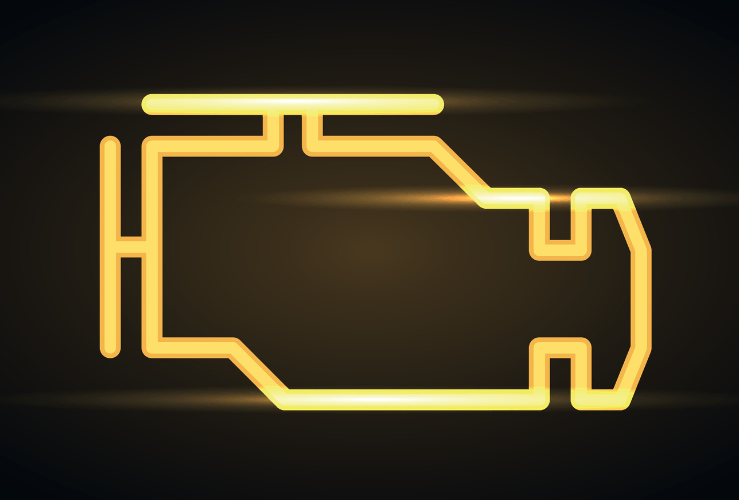Your car’s engine management light (EML) or ‘check engine light’ can come on for assorted reasons. Here we discuss the most common ones.
In most cases you should take your vehicle to a mechanic who will be able to diagnose and address the issue.
What is the Check engine light?
Your vehicle's check engine light is found on the dashboard behind the steering wheel.
It comes on if there's an issue with your engine or other associated parts.

Static amber check engine light
A static amber check engine light suggests there is a problem that could develop into something more serious.
In most cases, it's safe to continue driving, but you should get your vehicle checked out by a garage as soon as you can.
Flashing amber check engine light
If your check engine light flashes on and off, it suggests your car's sensors are picking up a problem intermittently.
Again, take your car to a professional to have it looked at as soon as possible.
Red check engine light
A red check engine light is more serious.
You should pull over somewhere safe and contact your breakdown recovery provider.
What to do when the engine light comes on
Because the check engine light can come on for all sorts of reasons, you'll need to take your car to a professional who can use special diagnostic systems to pinpoint the issue - and fix it.
Even if you suspect you know what the problem is, a professional mechanic will have the equipment and experience to get your car back on the road.
As mentioned, do not continue to drive if a red check engine light is illuminated.
What does the Engine Management Light mean?
'Engine management light' is synonymous with 'check engine light' - and means you have an issue with your engine, or other critical components in the drive system.
Engine Management Light and loss of power
If your engine management light is illuminated and your vehicle has lost power, you should contact your breakdown recovery provider, or get it looked at by a mechanic immediately. Common causes of loss of power include spark plug issues, and a blocked exhaust or fuel pump.

What can cause the Engine Management Light to come on?
Here are the most common reasons your engine management light may come on:
Oxygen Sensor: Fault/oxygen level issue
Your car's oxygen sensor may detect that your air-fuel mixture is either too 'lean' (too much oxygen) or too 'rich' (not enough oxygen). In both cases, the check engine light may come on.
However, oxygen sensors can malfunction, which will also cause the light to illuminate.
Mass Airflow Sensor
A faulty or blocked air filter can stop the mass airflow sensor from working properly, making it impossible for the ECU to determine how much fuel to add to the combustion chambers.
When this happens, the check engine light comes on.
Diesel Particulate Filter (DPF) blockage
In a diesel car, the DPF is a critical component that catches and stores soot from your exhaust, reducing the amount of air pollution your vehicle emits.
A problem with the differential pressure sensor means you won't know the DPF status - triggering the check engine light.
Ignition system problem (Petrol cars)
Spark plug or coil faults can make your check engine light flash.
Oil dipstick not secure
If your oil dipstick is loose, the check engine light may come on.
This can happen if you've just checked your oil and not replaced the dipstick properly.
Loose fuel cap
Your engine management light may come on if your fuel cap is loose.
This is one of the few issues that you can sort yourself - but only if you think to check it.
Once the cap is secure, the engine management light should go off.
OBD-II codes (After a problem is addressed)
Even after a problem has been fixed, you may still see the engine management light if the initial fault codes remain in the system. These codes are part of the OBD-II diagnostic system.
Loose wiring/connections
The engine management light may come on due to faulty wiring or connections.
While there is no fault with any of your car's components, such loose connections are a fault in themselves - because they'll continue to give you a false reading, so you won't know if something more serious has happened.
Low battery voltage
Low battery voltages can sometimes trigger the engine management light.
Your mechanic will be able to determine if the voltage is operating within the required range.

EML FAQs
How do I fix the Engine Management Light?
Unless you have significant mechanical knowledge (and the associated diagnostic equipment), you won't be able to determine why the engine management light has come on.
It's best to take your vehicle to a mechanic as soon as you can. And as stated, if the EML is red, you should pull over and call your breakdown provider immediately.
Will a car’s Engine Management Light reset itself?
It's unlikely the engine management light will reset itself. If you see the engine management light, there's almost certainly an issue with your vehicle.
If your mechanic cannot detect an issue, get them to reset the engine management light.
The light may stay on even after a fault has been fixed, but it will probably turn off after the car has been turned on, run for a while, and turned off (this may need to happen a few times for the light to go off).
Is it safe to drive with the Engine Management Light on?
If your engine management light remains amber (static or blinking), then it is probably safe to drive. However, you should get the issue checked out by your mechanic promptly.
If the light is red, you should not drive. Instead, park somewhere safe and call your breakdown recovery provider.




